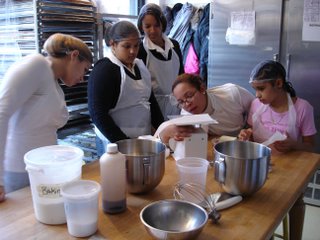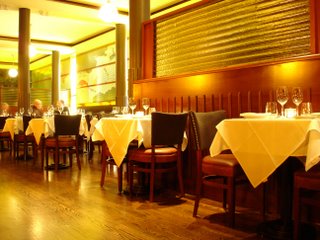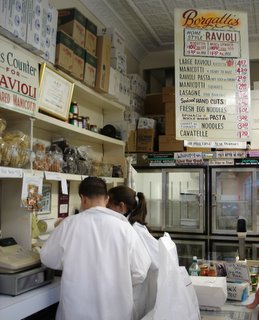SUGAR, SPICE & EVERYTHING NICE-Tough gals turn sweet by baking brownies (NY PRESS)

As soon as you enter the Sweet Things Bake Shop, the enchanting smell of baking cookies envelops you in its grip. There’s an old-fashioned feel to this tiny shop on Avenue C: glass vitrines stocked with cupcakes and cookies crowd the counter, an old enamel stove squats to one side and handmade aprons flutter in the sunny window.
Peek in the kitchen on a Wednesday or Thursday afternoon and the place takes on an even cozier picture. Girls ages nine to 17 weigh butter, crack eggs, mix batter and wash pots and pans—not a single Y chromosome to be found in the place.
The Girls Club of the Lower East Side owns the shop, which opened in 2004, and they use it to teach local girls about baking, cooking and running a small business. The heart of this program is a course called “Cooking Academy.”
Valerie Galindo, a former Girls Club member and a student at the Institute of Culinary Education, teaches the baking aspect of Cooking Academy.
She wears a white chef’s jacket and moves through the tiny kitchen with speed and confidence. On a recent afternoon, she showed her five eager students how to read a scale, how to prevent salmonella and, most exciting of all, how to make chocolate chip brownies from scratch.
Jodi Morrisson, a program volunteer and a business consultant for artists and nonprofits, teaches the business aspect of the course. She’s tall and young with dyed red hair and electric blue eyes.
“We sell a lot of brownies here at the bake shop? Why is that?” she asks the girls.
“Because they’re familiar,” answers Annise Ventura, a tough and articulate 13 year old with a baby face. “Everybody knows what goes into them. They know they’re good.”
“What can we do to sell more?” asks Jodi.
“Explain our product,” says Ventura. “Explain why it’s good.”
Morrisson teaches the girls about marketing, packaging, sales and customer relations. “Being nice is good business,” she explains.
The girls, in their hairnets and white, plastic aprons, nod their heads in agreement.
They are drawn to the program for a variety of reasons.
“Baking helps me release anger,” says Angelina Rosato, 13. She stands with her arms crossed and her lips pursed. “Instead of screaming or hitting something, I just bake at home.”
“I like the different tastes and ingredients you put into it—and the touch and the smells, “ says Christina Valentin, a shy 16 year old with kohl-rimmed eyes.
“I like being able to help own a business,” says Ventura. “As a little girl, I used to go to my cousin’s house everyday and we’d be bored, so we’d go out and make lemonade. We didn’t ask for money; we just gave it away. It was fun having a little place like that, and now I get to redo the experience without being that creepy 13-year-old still selling lemonade. Instead, I’m selling cookies at an actual, stable store.”
The club pays each girl a small stipend for finishing the course, and many graduates of the program go on to work in the shop during holidays, after school and over the summer. Lippy Khair (21, a former club member), Danyel Garcia (20, a baker in training) and Miladys Ramirez (the manager of the shop and the program) run the place from day-to-day. All profits go towards the organization, which is raising money for a new building.
The bakery is open Tuesday through Saturday, and neighborhood residents stream in and out at all hours of the day. Taste any one of their offerings and you’ll see why: The brownies are rich and chewy, the frosted cupcakes moist and flavorful and their whimsically decorated cookies melt in your mouth. Who says that learning can’t be sweet? And delicious, too.
The Sweet Things Bake Shop
136 Ave. C (betw. 8th & 9th Sts.)
212-982-1633


